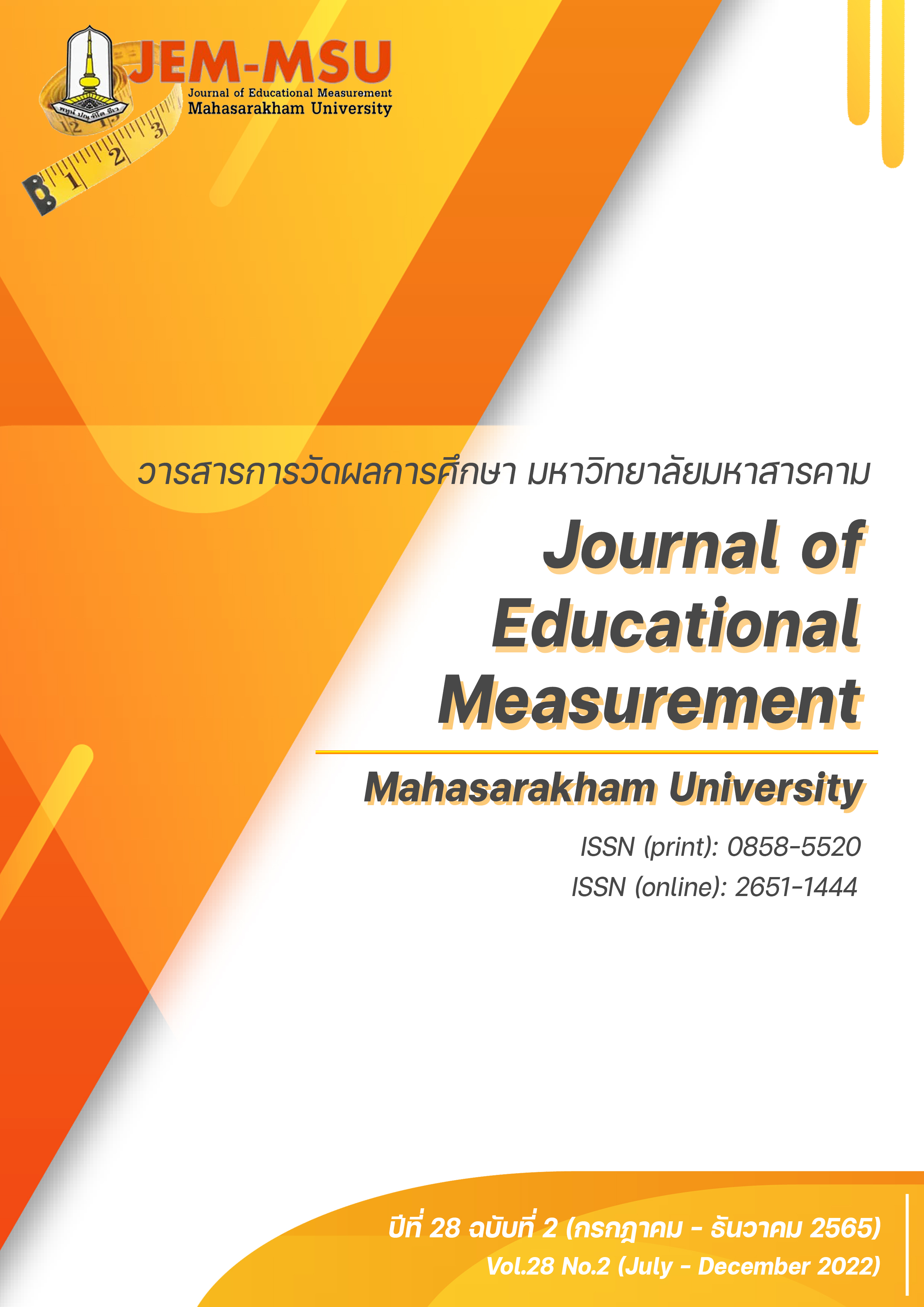การพัฒนารูปแบบการส่งเสริมการอ่านออกเขียนได้ กลุ่มสาระการเรียนรู้ภาษาไทย ระดับชั้นประถมศึกษาปีที่ 1
Main Article Content
บทคัดย่อ
การวิจัยครั้งนี้มีวัตถุประสงค์เพื่อ 1) ศึกษาปัญหาและแนวทางส่งเสริมการอ่านออกเขียนได้ 2) สร้างรูปแบบการส่งเสริมการอ่านออกเขียนได้ 3) ศึกษาผลการใช้รูปแบบการส่งเสริมการอ่านออกเขียนได้ และ 4) ประเมินประสิทธิผลของรูปแบบการส่งเสริมการอ่านออกเขียนได้ กลุ่มสาระการเรียนรู้ภาษาไทย ระดับชั้นประถมศึกษาปีที่ 1 การดำเนินการวิจัยใช้รูปแบบการวิจัยและพัฒนา 4 ระยะ คือ ระยะที่ 1 ศึกษาปัญหาและแนวทางส่งเสริมการอ่านออกเขียนได้จากตัวอย่างงานวิจัย จำนวน 42 เล่ม ในระบบสืบค้นฐานข้อมูลฉบับเต็มมหาวิทยาลัย (ThaiLis Digital Collection) ครูผู้สอนประจำชั้นประถมศึกษาปีที่ 1 จำนวน 164 คน และแบบทดสอบวินิจฉัยการอ่านออกเขียนได้ จำนวน 4 ฉบับ ระยะที่ 2 สร้างและตรวจสอบคุณภาพของรูปแบบ การส่งเสริมการอ่านออกเขียนได้ จากข้อมูลการวิจัยในระยะที่ 1 การวิจัยภาคสนามโดยการสัมภาษณ์เชิงลึกผู้เชี่ยวชาญ จำนวน 8 ท่าน และตรวจสอบคุณภาพของรูปแบบโดยผู้เชี่ยวชาญ จำนวน 8 ท่าน ระยะที่ 3 ทดลองใช้รูปแบบกับตัวอย่างนักเรียนชั้นประถมศึกษาปีที่ 1 โรงเรียนบ้านคูตัน จำนวน 12 คน ซึ่งได้มาโดยวิธีการสุ่มแบบกลุ่ม (cluster random sampling) กลุ่มเดียววัดหลายครั้งแบบอนุกรมเวลา วัดซ้ำก่อนเรียนและหลังเรียน จำนวน 4 ครั้ง ระยะที่ 4 ประเมินประสิทธิผลของรูปแบบโดยครูผู้ทดลองใช้รูปแบบจำนวน 2 ท่านครูผู้สอนชั้นประถมศึกษาปีที่ 1 ในสังกัดสำนักงานเขตพื้นที่การศึกษาสุรินทร์ เขต 3 ที่ได้รับการเผยแพร่ผลงานรูปแบบ จำนวน 31 คน และนักเรียนจำนวน 12 คน ตรวจสอบประสิทธิผลด้านการใช้ได้จริง ใช้ได้ง่าย มีความเหมาะสม และเป็นที่ต้องการ ผลการวิจัยพบว่า
1. ปัญหาและแนวทางส่งเสริมอ่านออกเขียนได้ มี 7 ปัญหา ได้แก่ 1) พยัญชนะ 2) สระ 3) วรรณยุกต์ 4) คำที่ไม่มีมาตราตัวสะกด 5) คำที่มีมาตราตัวสะกด 6) คำควบกล้ำ 7) คำที่มีอักษรนำ และมี 3 แนวทางการส่งเสริมการอ่านออกเขียนได้ ได้แก่ 1) การใช้รูปแบบการสอน 2) การใช้เทคนิคและวิธีการสอน และ 3) การใช้สื่อการเรียนรู้
2. รูปแบบการส่งเสริมการอ่านออกเขียนได้ ประกอบด้วย 11 องค์ประกอบ ได้แก่ 1) หลักการของรูปแบบ 2) วัตถุประสงค์ของรูปแบบ 3) เนื้อหาของรูปแบบ 4) ระยะเวลาจัดการเรียนรู้ตามรูปแบบ 5) กระบวนการ ส่งเสริมของรูปแบบ มี 5 ขั้น ได้แก่ (1) ขั้นวินิจฉัย (2) ขั้นวิทิสาสมาธิ (3) ขั้นอ่านออก (4) ขั้นเขียนได้ และ (5) ขั้นประเมินผล 6) บทบาทของครูตามรูปแบบ 7) บทบาทของนักเรียนตามรูปแบบ 8) บทบาทของผู้ปกครองตามรูปแบบ 9) สื่อการเรียนรู้ตามรูปแบบ 10) การวัดและประเมินผลตามรูปแบบ และ 11) ผลที่นักเรียนจะได้รับจากรูปแบบ
3. รูปแบบการส่งเสริมการอ่านออกเขียนได้ สามารถส่งเสริมการอ่านออกเขียนได้ของนักเรียนหลังเรียนสูงกว่าก่อนเรียน อย่างมีนัยสำคัญทางสถิติที่ระดับ .05
4. รูปแบบการส่งเสริมการอ่านออกเขียนได้มีประสิทธิผลในภาพรวมอยู่ในระดับมากที่สุด
Article Details

This work is licensed under a Creative Commons Attribution-NonCommercial-NoDerivatives 4.0 International License.
เนื้อหาและข้อมูลในบทความที่ลงตีพิมพ์ในวารสารการวัดผลการศึกษา มหาวิทยาลัยมหาสารคาม ถือเป็นข้อคิดเห็นและความรับผิดชอบของผู้เขียนบทความโดยตรง ซึ่งกองบรรณาธิการวารสาร ไม่จำเป็นต้องเห็นด้วย หรือร่วมรับผิดชอบใดๆ
บทความ ข้อมูล เนื้อหา รูปภาพ ฯลฯ ที่ได้รับการตีพิมพ์ในวารสารการวัดผลการศึกษา มหาวิทยาลัยมหาสารคาม ถือเป็นลิขสิทธิ์ของวารสารการวัดผลการศึกษา มหาวิทยาลัยมหาสารคาม หากบุคคลหรือหน่วยงานใดต้องการนำทั้งหมดหรือส่วนใดส่วนหนึ่งไปเผยแพร่ต่อหรือกระทำการใดๆ จะต้องได้รับอนุญาตเป็นลายลักษณ์อักษรจากวารสารการวัดผลการศึกษา มหาวิทยาลัยมหาสารคาม ก่อนเท่านั้น
References
Buasomboon, B., Chanchusakun, S., Varasunun, P. & Nata, N. (2016). Surveying and synthesizing research of instruction of reading and writing Thai in primary education. National Research Council of Thailand. (in Thai)
Bureau of Educational Testing. (2019). Reading Test for Academic year 2018. Aksornthai Press Limited. (in Thai)
liamprawat, S. (2008). Vernacular Study: Linguistics of the Tai. Silpakorn University. (in Thai)
Ministry of Education. (2008). The basic education core curriculum B.E.2551 (A.D.2008). Cooperative of Thailand Press. (in Thai)
Ministry of Education. (n.d.). Handbook of teaching reading and writing by distributing spelling. Thai language Institute, Bureau of academic affairs and educational standards. Office of the basic education commission. (in Thai)
Office of the Permanent Secretary, Ministry of Education. (2017). Annual Report 2016. Office of the Permanent Secretary, Ministry of Education. (in Thai)
Pandan, P. (2016). The Development a model for promoting the literacy efficiency in Primary students Grade 1-3 under Suphanburi primary educational service area office 3. National Institute for Development of Teachers, Faculty Staff and Educational Personnel. (in Thai)
Patoommasoot, S. (2008). Children can't read and write, one easy fix (8th ed.). Nawasan printing Press. (in Thai)
Pho - on, P. (2016). The Development Model of Teaching Reading for Understanding Thai Language for Prathomsuksa Students. VRU Research and Development Journal Humanities and Social Science. 11(3), 1 - 9. (in Thai)
Phusee - orn, S. (2018). Research and Development in Education. Tukkasila. (in Thai)
PISA Thailand, The Institute for the Promotion of Teaching Science and Technology. (2021). Factors affecting reading ability and ways to improve reading ability of Thai students. Success publication company limited. (in Thai)
Polsombat, P. (2012). The development of Thai language oral reading drills based on phonetics principles to enhance Thai pronunciation ability and attitudes towards Thai pronunciation for seventh grade students using Thai-Khmer dialect [Master's thesis]. ChulalongKon University. (in Thai)
Sapsombat W. (2019). Summary of reading ability assessment (RT) of primary student grade 1 for Academic year 2019. https://bet.obec.go.th/New2020/?p=2015. (in Thai)
Seedabut, P. (2016). A Phonological Study of A Khmer Dialect at Takhian Ram Sub - District, Phu Sing District, Si Sa Ket Province [Master's thesis]. Mahidol University. (in Thai)
TK Park. (2011). Thailand Conference on Reading 2011. Plan printing company limited. (in Thai)
Tuntavanith, P. (2012). A Model and Media Development for Improving Prathomsuksa 3 Students’ in Reading Ability which Appropriate with Local Context and Each Student Reading Ability. Department of Educational Testing and Research, Faculty of education, Surindra Rajabhat University. (in Thai)

